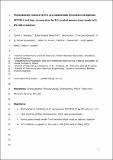Files in this item
Photocatalytic removal of the cyanobacterium Microcystis aeruginosa PCC7813 and four microcystins by TiO2 coated porous glass beads with UV-LED irradiation
Item metadata
| dc.contributor.author | Pestana, Carlos J. | |
| dc.contributor.author | Portela Noronha, Jolita | |
| dc.contributor.author | Hui, Jianing | |
| dc.contributor.author | Edwards, Christine | |
| dc.contributor.author | Gunaratne, H. Q.Nimal | |
| dc.contributor.author | Irvine, John T.S. | |
| dc.contributor.author | Robertson, Peter K.J. | |
| dc.contributor.author | Capelo-Neto, José | |
| dc.contributor.author | Lawton, Linda A. | |
| dc.date.accessioned | 2021-07-21T23:35:21Z | |
| dc.date.available | 2021-07-21T23:35:21Z | |
| dc.date.issued | 2020-11-25 | |
| dc.identifier | 269495364 | |
| dc.identifier | 41d6a589-5785-40ee-9a40-0a8cd9232a65 | |
| dc.identifier | 85088741674 | |
| dc.identifier | 000579365600076 | |
| dc.identifier.citation | Pestana , C J , Portela Noronha , J , Hui , J , Edwards , C , Gunaratne , H Q N , Irvine , J T S , Robertson , P K J , Capelo-Neto , J & Lawton , L A 2020 , ' Photocatalytic removal of the cyanobacterium Microcystis aeruginosa PCC7813 and four microcystins by TiO 2 coated porous glass beads with UV-LED irradiation ' , Science of the Total Environment , vol. 745 , 141154 . https://doi.org/10.1016/j.scitotenv.2020.141154 | en |
| dc.identifier.issn | 0048-9697 | |
| dc.identifier.other | ORCID: /0000-0002-8394-3359/work/78527538 | |
| dc.identifier.uri | https://hdl.handle.net/10023/23614 | |
| dc.description | The authors acknowledge the Engineering and Physical Sciences Research Council (EPSRC) for funding this research [EP/P029280/1]. | en |
| dc.description.abstract | Cyanobacteria and their toxic secondary metabolites are a challenge in water treatment due to increased biomass and dissolved metabolites in the raw water. Retrofitting existing water treatment infrastructure is prohibitively expensive or unfeasible, hence ‘in-reservoir’ treatment options are being explored. In the current study, a treatment system was able to photocatalytically inhibit the growth of Microcystis aeruginosa and remove released microcystins by photocatalysis using titanium dioxide coated, porous foamed glass beads and UV-LEDs (365 nm). A 35% reduction of M. aeruginosa PCC7813 cell density compared to control samples was achieved in seven days. As a function of cell removal, intracellular microcystins (microcystin-LR, -LY, -LW, and -LF) were removed by 49% from 0.69 to 0.35 μg mL−1 in seven days. Microcystins that leaked into the surrounding water from compromised cells were completely removed by photocatalysis. The findings of the current study demonstrate the feasibility of an in-reservoir treatment unit applying low cost UV-LEDs and porous foamed beads made from recycled glass coated with titanium dioxide as a means to control cyanobacteria and their toxins before they can reach the water treatment plant. | |
| dc.format.extent | 1052770 | |
| dc.language.iso | eng | |
| dc.relation.ispartof | Science of the Total Environment | en |
| dc.subject | Cyanobacteria | en |
| dc.subject | Cyanotoxins | en |
| dc.subject | Photocatalysis | en |
| dc.subject | Titanium dioxide | en |
| dc.subject | UV-LED | en |
| dc.subject | Water treatment | en |
| dc.subject | QD Chemistry | en |
| dc.subject | Environmental Engineering | en |
| dc.subject | Environmental Chemistry | en |
| dc.subject | Waste Management and Disposal | en |
| dc.subject | Pollution | en |
| dc.subject | NDAS | en |
| dc.subject.lcc | QD | en |
| dc.title | Photocatalytic removal of the cyanobacterium Microcystis aeruginosa PCC7813 and four microcystins by TiO2 coated porous glass beads with UV-LED irradiation | en |
| dc.type | Journal article | en |
| dc.contributor.sponsor | EPSRC | en |
| dc.contributor.institution | University of St Andrews. School of Chemistry | en |
| dc.contributor.institution | University of St Andrews. Centre for Designer Quantum Materials | en |
| dc.contributor.institution | University of St Andrews. EaSTCHEM | en |
| dc.identifier.doi | 10.1016/j.scitotenv.2020.141154 | |
| dc.description.status | Peer reviewed | en |
| dc.date.embargoedUntil | 2021-07-22 | |
| dc.identifier.grantnumber | EP/P029280/1 | en |
This item appears in the following Collection(s)
Items in the St Andrews Research Repository are protected by copyright, with all rights reserved, unless otherwise indicated.

